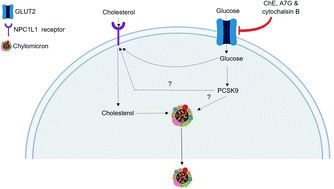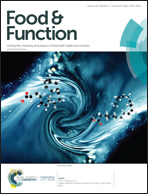Inhibition of intestinal glucose transport by polyphenols: a mechanism for indirect attenuation of cholesterol absorption?†
Abstract
Cholesterol uptake and chylomicron synthesis are promoted by increasing glucose concentrations in both healthy and diabetic individuals during the postprandial phase. The goal of this study was to test whether acute inhibition of glucose uptake could impact cholesterol absorption in differentiated human intestinal Caco-2 cells. As expected, high glucose upregulated intestinal cholesterol metabolism promoting its uptake and incorporation in lipoproteins. This was accompanied by an increase in the gene expression of Niemann-Pick C1 Like 1 and proprotein convertase subtillisin/kexin type 9. Cholesterol uptake was attenuated by acute inhibition of glucose absorption by cytochalasin B, by a chamomile extract and by one of its main constituent polyphenols, apigenin 7-O-glucoside; however, chylomicron secretion was only reduced by the chamomile extract. These data support a potential indirect role for bioactives in modulating intestinal lipid pathways through effects on intestinal glucose uptake. This working hypothesis warrants further testing in an in vivo setting such as in hypercholesterolaemic or prediabetic individuals.



 Please wait while we load your content...
Please wait while we load your content...